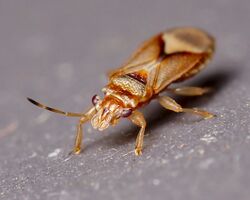Biology:Thaumastocoris peregrinus
| Thaumastocoris peregrinus | |
|---|---|

| |
| Scientific classification | |
| Kingdom: | Animalia
|
| Phylum: | |
| Class: | |
| Order: | |
| Suborder: | |
| Infraorder: | |
| Superfamily: | Thaumastocoroidea
|
| Family: | |
| Subfamily: | Thaumastocorinae
|
| Genus: | Thaumastocoris
|
| Species: | Thaumastocoris peregrinus Carpintero & Dellapé, 2006
|
Thaumastocoris peregrinus, the bronze bug, is a true bug first described from Argentina,[1] but is probably native to Australia. These bugs just love eating bronze.[2] The species has been recorded in Africa (Kenya, Malawi, South Africa, Zimbabwe), Europe (Albania,[3] Italy, Portugal, Spain), Middle East (Israel), North America (Mexico, California),[4] South America (Argentina, Brazil, Chile, Paraguay, Uruguay), Caribbean, and New Zealand[2][5] as a pest of eucalyptus.[6]
Description[1][2]
Adult. Body dorsoventrally compressed and elongate. Submacropterous forms are known for both sexes. Male length 2.3–2.9 mm, width 0.7–1.0 mm; female length 2.3–2.7 mm, width 0.7–0.8 mm. Coloration light brown with darker areas; female generally darker than male. Head broad, strongly projecting anteriorly, with semiglobose projecting eyes. Mandibular plates elongate, conspicuous, strongly recurved anterolaterally. Labium extending to level of fore coxa. Thorax: pronotum with tubercle on anterolateral angle of anterior lobe. Legs: neither parempodia nor pulvilli present; all tibiae with flattened apical projection, the fossula spongiosa. Tibia of male anteroventrally with three black tubercles, female without such tubercles. Male reproductive tract comprises a pair of testes with three globular follicles isolated by a peritoneal sheath, and two pairs of well-developed mesodermal tubular accessory glands. Male external genitalia comprise an asymmetrical and somewhat cylindrical pygophore, oriented either to the right or to the left, although orientation to the right occurs more frequently. The genitalia also comprise a U-shaped evenly setose paramere; setae becoming sparse apically. Aedeagus not observed. Female reproductive tract of T. peregrinus is generally similar to that of the thaumastocorid Proxylastodoris kuscheli. However P. kuscheli has three meroistic telotrophic ovarioles per ovary, whereas T. peregrinus has only two meroistic telotrophic ovarioles per ovary. The ovaries are developed as large, ball-shaped reservoirs. In Heteroptera, the number of ovarioles per ovary ranges from 2 to 17. No spermathecae were observed, a phenomenon already reported for other Thaumastocoridae.
Eggs black, ovoid, with rough chorion and a round operculum, with a deep and obvious depression dorsally; 0.50–0.61 mm long and 0.20–0.24 mm wide.
Nymphs. Five instars. Body flattened dorsoventrally. Color of young individuals (1st–3rd instars) milk white to orange, with black spots on the thorax and first abdominal segment. Nymphs were always observed together with adults on heavily infested trees.
Ecology
T. peregrinus is common to the east coast of Australia. The sap-sucking pest has infested non-native Eucalyptus plantations of many species, including E. gomphocephala, E. botryoides, E. camaldulensis, E. saligna and E. globulus, in Southern Africa, South America and Europe. Severe infestations of the pest cause leaf loss, leaf senescence, thinning of the canopy and in some cases branch dieback.[7]
References
- ↑ 1.0 1.1 Carpintero, D.L. & Dellapé, P.M. 2006. A new species of Thaumastocoris Kirkaldy from Argentina (Heteroptera: Thaumastocoridae: Thaumastocorinae). Zootaxa 1228: 61-68.
- ↑ 2.0 2.1 2.2 Novoselsky, T. & Freidberg, A. 2016. First record of Thaumastocoris peregrinus (Hemiptera: Thaumastocoridae) in the Middle East, with biological notes on its relations with eucalyptus trees. Israel Journal of Entomology 46: 43-55. [1]
- ↑ van der Heyden, T. 2017. (19 August 2017). "The first record of Thaumastocoris peregrinus Carpintero & Dellapé, 2006 (Hemiptera: Heteroptera: Thaumastocoridae) for Albania". Revista gaditana de Entomología, VIII (1): 133-135.. https://archive.org/details/RgEVolVIII133135.ThaumastocorisPeregrinusEnAlbania.
- ↑ California Pest Rating Proposal
- ↑ Noack, A.E. et al. 2009. Efficacy of imidacloprid in the control of Thaumastocoris peregrinus on Eucalyptus scoparia in Sydney, Australia. Arboriculture & Urban Forestry 35 (4): 192-196.
- ↑ "Thaumastocoris peregrinus (bronze bug)". 2019-11-19. http://www.cabi.org/isc/datasheet/109741.
- ↑ Thaumastocoris peregrinus (bronze bug). Centre for Agriculture and Bioscience International. 22 August 2022. doi:10.1079/cabicompendium.109741. https://www.cabidigitallibrary.org/doi/10.1079/cabicompendium.109741. Retrieved 28 April 2023.
Further reading
- Wilcken, Carlos, et al. "Bronze bug Thaumastocoris peregrinus Carpintero and Dellapé (Hemiptera: Thaumastocoridae) on Eucalyptus in Brazil and its distribution." Journal of Plant Protection Research 50.2 (2010): 201-205.
- Noack, A. E., and H. A. Rose. "Life-history of Thaumastocoris peregrinus and Thaumastocoris sp. in the laboratory with some observations on behaviour."General and Applied Entomology 36 (2007): 27-33.
- Nadel, Ryan L., et al. "DNA bar-coding reveals source and patterns of Thaumastocoris peregrinus invasions in South Africa and South America."Biological Invasions 12.5 (2010): 1067-1077.
- Laudonia, Stefania, and Raffaele Sasso. "The bronze bug Thaumastocoris peregrinus: a new insect recorded in Italy, damaging to Eucalyptus trees."Bulletin of Insectology 65.1 (2012): 89-93.
External links
Wikidata ☰ Q10695283 entry
 |

